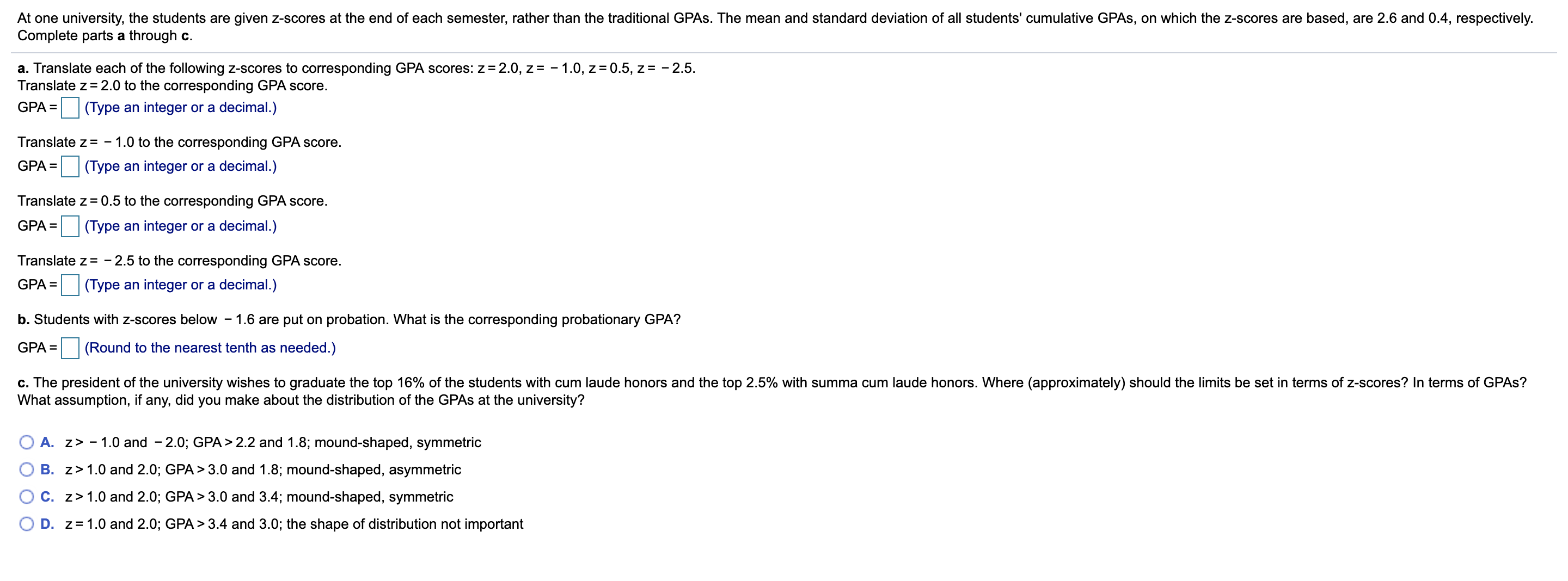At one university, the students are given z-scores at the end of each semester, rather than the traditional GPAS. The mean and standard deviation of all students' cumulative GPAS, on which the z-scores are based, are 2.6 and 0.4, respectively. Complete parts a through c. a. Translate each of the following z-scores to corresponding GPA scores: z= 2.0, z= - 1.0, z= 0.5, z= - 2.5. Translate z = 2.0 to the corresponding GPA score. GPA = (Type an integer or a decimal.) Translate z = - 1.0 to the corresponding GPA score. GPA = (Type an integer or a decimal.) %3D Translate z = 0.5 to the corresponding GPA score. GPA = (Type an integer or a decimal.) Translate z= - 2.5 to the corresponding GPA score. GPA = (Type an integer or a decimal.) b. Students with z-scores below - 1.6 are put on probation. What is the corresponding probationary GPA? GPA = (Round to the nearest tenth as needed.) c. The president of the university wishes to graduate the top 16% of the students with cum laude honors and the top 2.5% with summa cum laude honors. Where (approximately) should the limits be set in terms of z-scores? In terms of GPAS? What assumption, if any, did you make about the distribution of the GPAS at the university? O A. z> - 1.0 and - 2.0; GPA > 2.2 and 1.8; mound-shaped, symmetric B. z> 1.0 and 2.0; GPA > 3.0 and 1.8; mound-shaped, asymmetric C. z>1.0 and 2.0; GPA> 3.0 and 3.4; mound-shaped, symmetric D. z= 1.0 and 2.0; GPA > 3.4 and 3.0; the shape of distribution not important
At one university, the students are given z-scores at the end of each semester, rather than the traditional GPAS. The mean and standard deviation of all students' cumulative GPAS, on which the z-scores are based, are 2.6 and 0.4, respectively. Complete parts a through c. a. Translate each of the following z-scores to corresponding GPA scores: z= 2.0, z= - 1.0, z= 0.5, z= - 2.5. Translate z = 2.0 to the corresponding GPA score. GPA = (Type an integer or a decimal.) Translate z = - 1.0 to the corresponding GPA score. GPA = (Type an integer or a decimal.) %3D Translate z = 0.5 to the corresponding GPA score. GPA = (Type an integer or a decimal.) Translate z= - 2.5 to the corresponding GPA score. GPA = (Type an integer or a decimal.) b. Students with z-scores below - 1.6 are put on probation. What is the corresponding probationary GPA? GPA = (Round to the nearest tenth as needed.) c. The president of the university wishes to graduate the top 16% of the students with cum laude honors and the top 2.5% with summa cum laude honors. Where (approximately) should the limits be set in terms of z-scores? In terms of GPAS? What assumption, if any, did you make about the distribution of the GPAS at the university? O A. z> - 1.0 and - 2.0; GPA > 2.2 and 1.8; mound-shaped, symmetric B. z> 1.0 and 2.0; GPA > 3.0 and 1.8; mound-shaped, asymmetric C. z>1.0 and 2.0; GPA> 3.0 and 3.4; mound-shaped, symmetric D. z= 1.0 and 2.0; GPA > 3.4 and 3.0; the shape of distribution not important
Glencoe Algebra 1, Student Edition, 9780079039897, 0079039898, 2018
18th Edition
ISBN:9780079039897
Author:Carter
Publisher:Carter
Chapter10: Statistics
Section10.4: Distributions Of Data
Problem 19PFA
Related questions
Question

Transcribed Image Text:At one university, the students are given z-scores at the end of each semester, rather than the traditional GPAS. The mean and standard deviation of all students' cumulative GPAS, on which the z-scores are based, are 2.6 and 0.4, respectively.
Complete parts a through c.
a. Translate each of the following z-scores to corresponding GPA scores: z= 2.0, z= - 1.0, z= 0.5, z= - 2.5.
Translate z = 2.0 to the corresponding GPA score.
GPA =
(Type an integer or a decimal.)
Translate z = - 1.0 to the corresponding GPA score.
GPA = (Type an integer or a decimal.)
%3D
Translate z = 0.5 to the corresponding GPA score.
GPA =
(Type an integer or a decimal.)
Translate z= - 2.5 to the corresponding GPA score.
GPA =
(Type an integer or a decimal.)
b. Students with z-scores below - 1.6 are put on probation. What is the corresponding probationary GPA?
GPA = (Round to the nearest tenth as needed.)
c. The president of the university wishes to graduate the top 16% of the students with cum laude honors and the top 2.5% with summa cum laude honors. Where (approximately) should the limits be set in terms of z-scores? In terms of GPAS?
What assumption, if any, did you make about the distribution of the GPAS at the university?
O A. z> - 1.0 and - 2.0; GPA > 2.2 and 1.8; mound-shaped, symmetric
B. z> 1.0 and 2.0; GPA > 3.0 and 1.8; mound-shaped, asymmetric
C. z>1.0 and 2.0; GPA> 3.0 and 3.4; mound-shaped, symmetric
D. z= 1.0 and 2.0; GPA > 3.4 and 3.0; the shape of distribution not important
Expert Solution
This question has been solved!
Explore an expertly crafted, step-by-step solution for a thorough understanding of key concepts.
This is a popular solution!
Trending now
This is a popular solution!
Step by step
Solved in 2 steps with 6 images

Knowledge Booster
Learn more about
Need a deep-dive on the concept behind this application? Look no further. Learn more about this topic, statistics and related others by exploring similar questions and additional content below.Recommended textbooks for you

Glencoe Algebra 1, Student Edition, 9780079039897…
Algebra
ISBN:
9780079039897
Author:
Carter
Publisher:
McGraw Hill

Glencoe Algebra 1, Student Edition, 9780079039897…
Algebra
ISBN:
9780079039897
Author:
Carter
Publisher:
McGraw Hill